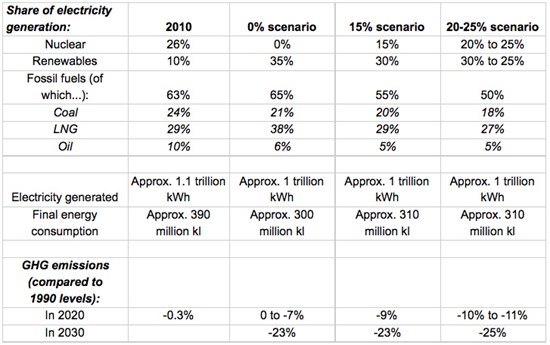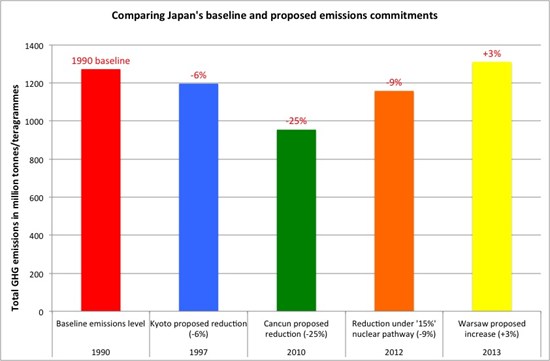Mat Hope
22.11.2013 | 1:00pmA reactor meltdown at the Fukushima nuclear plant in 2011 fundamentally changed the way the Japanese government and public saw their energy landscape. Now, the disaster is being used to justify a decision to relax Japan’s commitments to cut greenhouse gases.
Japan stunned delegates at the Warsaw climate conference this week by announcing it would abandon its target to reduce emissions by 25 per cent by 2020. Instead, the country’s negotiators proposed a new goal which would effectively allow emissions to increase around three per cent on 1990 levels.
The Japanese government said the Fukushima disaster – and the subsequent scaling back of nuclear power in the country – justified its decision.
Environmental NGOs and other participating governments are not convinced by Japan’s reasoning, however. The UK energy secretary, Ed Davey, said that with political will and public backing, Japan could do more to reduce emissions.
Missing the goal
Although it was only formally announced last Friday, documents we’ve found show Japan’s abandonment of its Cancun targets has been on the cards for a while.
In 2010, just over a quarter of Japan’s electricity came from nuclear power – and the government had ambitions for nuclear to eventually provide 50 per cent of electricity, which would have enabled a big cut in emissions.
But after a tsunami caused three reactors at the Fukushima plant to melt down in 2011, the government decided to immediately start closing all of Japan’s nuclear power plants. The disaster and resulting public antipathy towards nuclear power prompted a wholesale revision of Japan’s energy policy.
The following year the government released a document outlining three potential future directions for Japan’s energy policy, based on different levels of nuclear power. Any planned nuclear expansion had been ruled out. And none of the proposed pathways hit Japan’s 25 per cent reduction target.
This suggests the government was already planning to give up on its Cancun emissions reductions commitment, more than a year before it was officially announced at Warsaw.
But while these scenarios are not as ambitious as the Cancun pledge, they still imply modest emissions cuts. None of them imply that emissions would actually go up – which is what the Japanese government is now proposing.
The table below outlines how the government was proposing to transform its energy sector compared to 2010, and the emissions reductions it thought it could deliver:
Source: Data from Japanese Energy and Environment Council’s Options for Energy and the Environment; table by Carbon Brief
As you might expect, the more nuclear power the country proposed using, the bigger the emissions cuts expected.
But even under a scenario with no nuclear power at all, the Japanese government thought it could cut emissions by between zero and seven per cent by 2020.
In fact, a few months after the document was released, the government decided adopt a scenario in which nuclear makes up 15 per cent of Japan’s electricity generation – with the aim to eventually phase out nuclear power completely.
According to the government analysis, this should allow Japan to reduce its emissions nine per cent by 2020. That’s a smaller reduction than Japan’s international commitment of a 25 per cent cut. But it’s greater than Japan’s proposal under the Kyoto protocol in 1997, and considerably more ambitious than the three per cent rise announced in Warsaw.
This suggests the relaxation of Japan’s emissions targets we saw last week can’t be explained solely by its decision to reduce nuclear power. If that were the only thing that has changed, we might expect to see Japan cutting emissions by about nine per cent, not raising them by three per cent.
Source: Data from Options for Energy and the Environment UNFCCC GHG emissions data and Cancun Annex 1 emissions reduction targets; table by Carbon Brief
Justifying a three per cent rise
So what else is behind the emissions hike? The state of Japan’s economy after the Fukushima disaster holds the clue. Japan’s economy was hit hard, and the government made boosting economic growth a priority.
Japan’s current prime minister, Shinzo Abe, has previously stated that the decision to phase out nuclear – taken by the previous government – was too hasty. Analysis by business consultancy, the Economist Intelligence Unit (EIU), suggests Abe is counting on a supply of cheap and reliable fossil fuels to help to drive his overarching economic agenda.
Greenpeace blog EnergyDesk suggested that in a scenario where Japan’s nuclear power was swapped for gas power, and were renewables ramped up annually at the same rate as in the past 12 months, Japan could cut its emissions by 17 per cent by 2020. That still misses Japan’s original emissions reduction target, but not by such a large margin.
But Simon Baptist, Regional Director for Asia at the Economist’s Intelligence Unit, says current fuel costs make that scenario unlikely. Liquefied natural gas – Japan’s only gas source – currently costs the country about $16 per million British thermal units, Baptist says. In contrast, the equivalent amount of coal costs around $4. So coal is by far Japan’s cheapest option, he argues.
The nuclear rollback meant Japan had to replace 26 per cent of its energy capacity – and fast. The current low levels of renewable power meant that even if wind and solar capacity grew quickly, it wouldn’t be able to replace nuclear power. Since gas is so expensive – and Japan is desperate for cheap energy options – it means it will turn to coal.
In that context, abandoning climate targets looks more like a way for the government to remove any carbon constraints which could harm a coal-driven economic recovery.
Saint or sinner
Japan points to progress in other areas as evidence that it hasn’t completely abandoned its climate change commitments.
For instance, each scenario in the energy plan would cut energy consumption by 10 per cent compared to 2010, mainly through improving the energy efficiency of Japan’s households. The government has also given Egypt over £200 million in loans to develop its wind power industry.
Baptist says Japan should be seen as “neither a saint or a sinner” in the climate negotiations. He says the political landscape post-Fukushima is such that “whatever the target, emissions reductions are a long way off”.
Nonetheless, the government’s decision to allow emissions to rise can’t be justified solely by the energy shift following nuclear disaster. In short, Japan’s motivation for drastically altering its climate commitments can be summarised in one word – but it’s not ‘nuclear’; it’s ‘economics’.
-
Japan's nuclear rollback doesn't fully explain why it's relaxing climate targets



